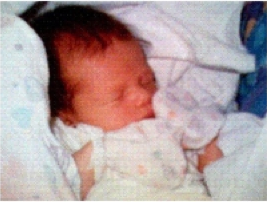
This is apparently the first picture taken and sent by a cell phone. It is Philippe Kahn's daughter, born June 11, 1997. Kahn is a Silicon Valley entrepreneur who founded Borland, and then in 1994, he founded Starfish, a wearable computer software company, with his wife Sonia Lee.
Kahn's integration of a digital camera to a Motorola StarTAC, one of the first flip phones, is considered the first phone camera. Kahn's Wikipedia:
Kahn founded LightSurf in 1998 shortly after he had created the first camera phone solution sharing pictures instantly on public networks in 1997. The impetus for this invention was the birth of Kahn's daughter; he jury-rigged a mobile phone with a digital camera and sent off photos in real time.This Slate podcast profile of Kahn from the dawn of the phonecam era, 2007, put it a little differently:
Ten years ago, Philippe Kahn was walking around a hospital with a cell phone and a digital camera. His dadly mission: to share pictures of his newborn baby girl. With an assist from Radio Shack, he linked the two devices together and e-mailed photos to family and friends around the world. The day marked a twin birth of sorts: the cell phone camera and daughter Sophie. [emphasis added]While Kahn's milestone has been celebrated every time somebody discovers it and decides to write about it [ahem], the details of how he actually executed the hack are more elusive.
An [OG] Wired Magazine article from 2000 mentions a keychain-sized camera attachment [that was coming that year, 2000, for one line of Motorola phones], and describes Kahn's original hack here:
Kahn came up with the idea for LightSurf three years ago, when he tried to send an ephoto of his newborn daughter to her grandmother. While many new dads would be looking around for a shave and a stiff drink, Kahn was crawling the maternity ward for an RJ11 jack [i.e., a phone jack]. With no landline in sight, he built a crude wireless photo application in Borland C++ and sent the pictures over a 2,400-bps connection from his StarTAC. Later, figuring there had to be better way, he brought together a team and set out to design a way to send a slender image file for online use and a larger one for printing hard copy. It worked just as he imagined.OK. So the assist from Radio Shack was a modem? [update: Not likely. It was probably Starfish's TrueSync connectivity solution, which, as DT 90's mobile guru Micah points out, was offered as a product by Motorola in 1999 (pdf). Daddy Types regrets the error.] Because a laptop was involved here. Photos synced to a laptop from a digital camera, laptop connected to
The send pictures to Grandma angle rings true, but in this 2012 Best Buy Superbowl ad [?], Kahn talks about two thousand people seeing that first photo. So he also invented spamming people with baby pictures? Do people even send out pictures of their fourth kid? Maybe he had a listserv. Or it was a webpage.
Anyway, as with most complicated births, the messy details are quickly subsumed by the baby in front of you. Starfish was acquired by Motorola in 1998 for $325 million; LightSurf was founded in 1998 and acquired by VeriSign in 2005 for $300 million. Whether Kahn's kid put Nirvana baby of the phonecam generation on her college applications remains unknown.
Philippe Kahn [wikipedia]
2007: The Camera Phone [slate]
2000: The Big Picture [wired]
1998 speech on wearables Kahn gave at Stanford [stanford.edu]




